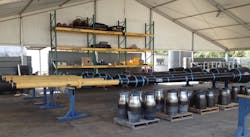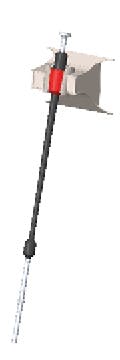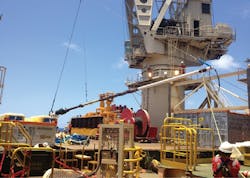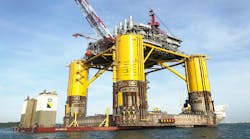Cost-effective technology for deepwater operations
Jeffry Lehner
Chris Caldwell
Arconic Energy Systems
Titanium stress joint assemblies prior to installation on the Delta House FPS.
The unique properties of titanium – light weight, high strength, and remarkable flexibility – are well recognized by engineers and metallurgists. Yet, titanium’s higher cost can sometimes deter its use in all but the most demanding oil and gas applications. Conventional wisdom says that in a period of low oil prices, designers should opt for the least expensive material that meets minimum specifications. But, as a collaboration between Arconic and LLOG demonstrates, premium titanium technology can be the most cost-effective solution, especially for components that must endure high stress and provide decades of uninterrupted, low maintenance service.
Standardization
In 2012, before making any proved discoveries, LLOG began planning an ambitious project to develop three potential Mississippi Canyon fields with subsea wells and to build and install a hub, floating in 4,435 ft (1,352 m) of water to receive, process, and export up to 100,000 b/d of crude oil and 240 MMcf of natural gas. Titanium stress joint technology from Arconic (then RTI International Metals) proved critical to the ongoing success of the project.
Titanium stress joint in FPS porch. (All images courtesy Arconic Energy Systems)
LLOG’s strategy involved batch drilling wells through subsea templates, using an FPS with a design similar to its Who Dat facility, and using standardized components to meet an accelerated timeline, while reducing lifting costs and overall cost of ownership.
“Standardization is a common theme,” said Rick Fowler, LLOG’s vice president for deepwater projects, “and I think LLOG does a great job of it. Offshore projects still typically involve many custom designs, but LLOG uses industry standards or works with suppliers to set our own standards, which saves time and money.”
By 2014, LLOG’s Delta House semisubmersible production platform would require two production steel catenary risers (SCR) each from the Marmalard, SOB2, and Niedermeyer fields, as well as the oil and gas export risers needed to connect to pipeline infrastructure. The eight SCRs would have to be connected to the floating host platform with pliant joints strong enough to support the weight of the risers and withstand the forces caused by currents and wave action on the platform and extreme weather conditions. The riser connections also would need to perform reliably with minimal maintenance for the 20-plus year lifespan of the facility. “On semi production facilities, heave is the enemy. Motion on the pipe can create fatigue,” Fowler said. “We can manage that fatigue by choosing the right design and material for the stress joints.”
Stress joint options
Operators have three options when selecting joints to connect SCRs to floating production facilities: flexible joints, steel tapered stress joints, and titanium stress joints (TSJ). Flexible joints accommodate platform motion with mechanical joints that include elastomeric components. While flexible joints can be a viable solution, their reliance on elastomers can present design challenges at extreme temperatures and during pressure fluctuations. Also, their elastomeric components have experienced long-term reliability issues causing both flowline and full facility shutdowns during repair. Steel tapered stress joints eliminate these failure risks with their all-metal construction, but must be heavy (thick) and long enough (typically 80 ft or more) to provide adequate strength and flexibility, which makes them expensive and difficult to handle and install.
Titanium stress joints (TSJs) provide a more reliable and compact alternative to flexible joints and steel tapered stress joints, making them easier to install and compatible with more design options. Titanium is twice as strong as steel and much more flexible. While each project has its own requirements, TSJs for deepwater applications typically are 75% shorter, 60% thinner, 80% more flexible, and provide significantly better fatigue resistance than steel tapered stress joints. These attributes were critical for the Delta House platform, which included an innovative riser porch design that could accommodate a total of 18 risers.
In addition, TSJs are reliable. More than 100 TSJs have been successfully applied on more than 20 wet tree projects over the past 20 years. TSJs have been used to connect SCRs to TLPs, spars, and semisubmersible platforms without any operational failures.
“TSJs were some of the most critical pieces of the Delta House platform project,” Fowler said. “They were also among the most technologically sophisticated. Because of titanium’s greater fatigue resistance, it is a better choice than steel. However, TSJs have to be engineered and manufactured to meet very tight tolerances, so we relied on Arconic’s engineering expertise to deliver the right solution.”
Titanium stress joint prior to installation.
Underwater photograph of TSJ during installation in Delta House FPS porch.
Standardized TSJs
“In working with Arconic, LLOG decided that all the 6-in. and 8-in. riser stress joints would have standard designs,” Fowler said. “Standardization of TSJs was important to the project because they tend to be critical, long lead-time items. By standardizing, we could take them off the critical path.”
Prior to the Delta House project, Arconic had begun to standardize components for TSJs and had enough forgings in stock to build the TSJs for Delta House. The company also had in-house control over the entire manufacturing process at its aerospace-quality facilities, so it could deliver all eight TSJs within the required project schedule.
In addition, Arconic’s engineers and metallurgists worked with the riser engineering firm 2H Offshore to ensure the TSJs and SCRs were designed and built to meet all project requirements.
Galvanic and chemical compatibility
Titanium is extremely corrosion resistant. By itself, titanium would remain corrosion free for far longer than the service life of a subsea riser. When titanium is coupled with a dissimilar metal, in this case the steel riser, special consideration is required to ensure galvanic compatibility for the life of the system. In these applications, polymeric and elastomeric coatings, specialized ceramics, and custom fiber reinforced composites are used to ensure galvanic compatibility between the TSJ and steel riser. These technologies are mature and field proven, having been deployed for the past 20 years on all TSJs used underwater with steel risers.
TSJs use a NACE sour-service rated titanium grade developed by Arconic to be compatible with produced well fluids and the vast majority of injected well chemicals. Unlike steel, titanium is highly corrosion resistant to seawater, hydrocarbons, NaCl brines, organic acids, CO2, H2S, elemental sulfur, and liquid mercury. However, special precautions should be employed when injecting hydrochloric (HCl) acid and methanol (MeOH) containing solutions. Arconic has mitigation strategies available on customer request for MeOH and HCl compatibility. Operators also have expressed their desire to perform well stimulation with hydrofluoric (HF) acid. Responding to these requests, the company developed and published a suite of chemical inhibitors specifically for this purpose. Many large oilfield service companies are currently working with Arconic to incorporate these HF inhibitors into their product offerings.
Unique riser installation method
Exmar, the hull designer, devised a unique procedure to install the TSJ/SCR combination on the Delta House FPS. Instead of using a heavy-lift crane, steering winches and divers, the Delta House team used a new riser pull method that employed a single winch, sheaves, and precise ballast adjustments on the FPS.
Once the riser and pipeline end terminal were lowered to the seafloor off the installation vessel, the TSJ was welded to the top end of the riser and a pull head was attached. An ROV connected the winch cable. Next, FPS ballast levels were adjusted to achieve up to 4° of list, creating clearance between the lifting cable and the pontoon and facilitating hang off of the TSJ in the riser adapter. After the winch pulled in the riser, the clearance increased until the riser was positioned above the adapter in the porch. Ballast was then transferred to reduce list and trim, causing the FPS to move upward toward the riser, setting it in place in the adapter. All eight SCRs were installed successfully without incident.
Additional tie-ins to Delta House
Since the initial installations, two more SCRs with TSJs have been installed on the FPS, connecting the LLOG-operated Otis field and the Deep Gulf Energy-operated Odd Job field to the Delta House hub. The facility is currently processing 95,000 b/d of oil from a total of 12 producing wells.
Taking advantage of its commitment to standardization, LLOG purchased three additional TSJs in 2016 in advance of future discoveries. Since then, the TSJs have been slated to tie in three additional fields to the FPS by the end of 2018, La Femme, Blue Wing Olive, and Red Zinger, to take production from four more wells.
“Delta House has been an exceptional project,” Fowler said, “in terms of safety, regulatory compliance, speed, production, and overall economics. We consider Arconic to be a valuable member of our team.”
The authors
Jeffry Lehner is Commercial Director for Arconic Energy Systems, following a 35-year career in technical roles at Alcoa. Most recently he served as general technical manager for Alcoa Oil and Gas, which was combined with RTI Energy Systems in 2015 and became Arconic Energy Systems in 2016.
Chris Caldwell is Director of Product Engineering for Arconic Energy Systems. Previously he spent 15 years in product technology and management roles at RTI Energy Systems, a leading titanium products supplier, which was acquired by Alcoa in 2015 and became part of Arconic in 2016. He holds a BS degree in mechanical engineering from the University of Texas at Austin.









